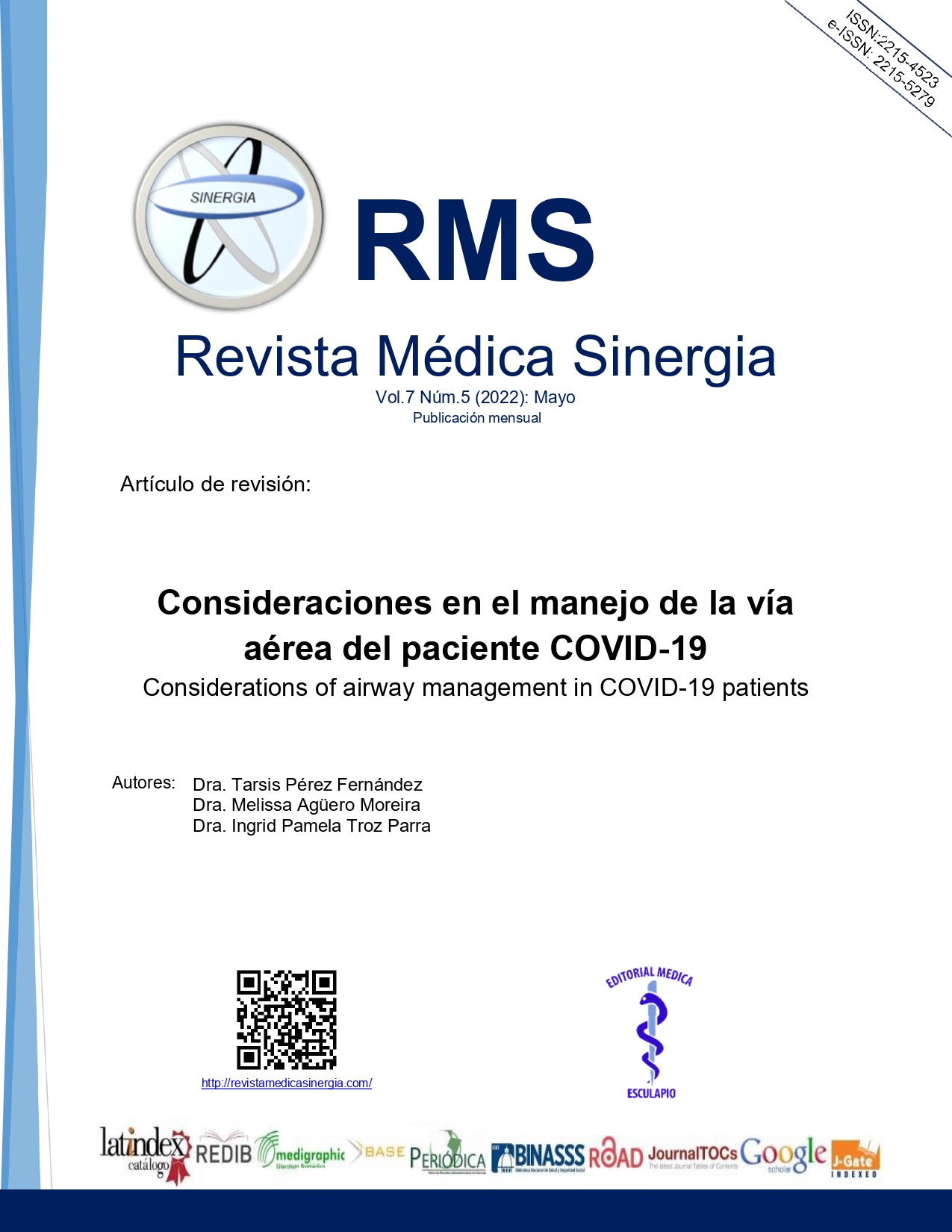Resumen
El manejo de la vía aérea de los pacientes diagnosticados con COVID-19 se considera de alto riesgo de contagio para el personal de salud involucrado, por tanto, es fundamental su conocimiento por parte de todos los involucrados en este escenario. Al momento de manejar la vía aérea de un paciente COVID-19, se realizan un total de 8 pasos, los cuales abarcan: la colocación del equipo de protección personal, la preparación tanto del área de aislamiento como del personal involucrado y el equipo de uso, la preoxigenación, la inducción, la intubación, la confirmación del tubo y colocación de sonda nasogástrica y por último, el retiro del equipo de protección. Para la extubación del paciente COVID-19, se debe realizar lo necesario para minimizar el reflejo tusivo y por ende, la exposición a secreciones; se debe preparar y comprobar todo el equipo necesario previo y posterior a la extubación.
Palabras clave
Citas
Monsalve J, Canales P, Catalá J, Moreno B. Guía de manejo de la vía aérea en el paciente crítico adulto. Rev Electrón Anestesia R [Internet]. 2019;11(9):4. doi: http://dx.doi.org/10.30445/rear.v11i9.788
Abuabara-Franco E, Díaz-Rendón MA, Romero-Henríquez A, Herrera-Cogollo N, Bohórquez-Rivero J, Uparella-Gulfo I. Airway management in COVID-19 diagnostic patient. Salud Uninorte [Internet]. 2021;36(1):256-80. doi: http://dx.doi.org/10.14482/sun.36.1.616.213
Quintero Cifuentes IF, Universidad Icesi. Fundamentos para la evaluación y manejo de la vía aérea. Universidad Icesi; 2020. Cap 1. pp. 15-41.
Data at WHO [Internet]. Who.int. [citado 24 de marzo de 2022]. Disponible a partir de: https://www.who.int/data/
Ugarte KV. Situación Nacional Covid-19 [Internet]. Ministerio de Salud Costa Rica. [citado 24 de marzo de 2022]. Disponible a partir de: https://www.ministeriodesalud.go.cr/index.php/centro-de-prensa/noticias/741-noticias-2020/1725-situacion-nacional-covid-19
Maestro AB. Consideraciones sobre el manejo de la Vía Aérea en el paciente con Covid-19 [Internet]. AnestesiaR. 2021 [citado 24 de marzo de 2022]. Disponible a partir de: https://anestesiar.org/2021/consideraciones-sobre-el-manejo-de-la-via-aerea-en-el-paciente-con-covid-19/
Camacho-Vacherón V, Salamanca-Sana YT, Carrillo-Torres O, Forero-Vega JS. Protocolo de manejo de la vía aérea en pacientes con sospecha o diagnóstico de SARS-CoV-2/COVID-19. Revista Mexicana de Anestesiología [Internet]. 2020;43(4):225-9. doi: http://dx.doi.org/10.35366/94933
Infection prevention and control for seasonal respiratory infections in health and care settings (including SARS-CoV-2) for winter 2021 to 2022 [Internet]. GOV.UK. [cited Mar 24, 2022]. Disponible a partir de: https://www.gov.uk/government/publications/wuhan-novel-coronavirus-infection-prevention-and-control/covid-19-guidance-for-maintaining-services-within-health-and-care-settings-infection-prevention-and-control-recommendations
Cook TM, El-Boghdadly K, McGuire B, McNarry AF, Patel A, Higgs A. Consensus guidelines for managing the airway in patients with COVID-19: Guidelines from the Difficult Airway Society, the Association of Anaesthetists the Intensive Care Society, the Faculty of Intensive Care Medicine and the Royal College of Anaesthetists: Guidelines from the Difficult Airway Society, the Association of Anaesthetists the Intensive Care Society, the Faculty of Intensive Care Medicine and the Royal College of Anaesthetists. Anaesthesia [Internet]. 2020;75(6):785-99. doi: http://dx.doi.org/10.1111/anae.15054
Brewster DJ, Chrimes N, Do TB, Fraser K, Groombridge CJ, Higgs A, et al. Consensus statement: Safe Airway Society principles of airway management and tracheal intubation specific to the COVID-19 adult patient group. Med J Aust [Internet]. 2020;212(10):472-81. doi: http://dx.doi.org/10.5694/mja2.50598
Canelli R, Connor CW, Gonzalez M, Nozari A, Ortega R. Barrier Enclosure during Endotracheal Intubation. N Engl J Med [Internet]. 2020;382(20):1957-8. doi: http://dx.doi.org/10.1056/NEJMc2007589
Yao W, Wang T, Jiang B, Gao F, Wang L, Zheng H, et al. Emergency tracheal intubation in 202 patients with COVID-19 in Wuhan, China: lessons learnt and international expert recommendations. Br J Anaesth [Internet]. 2020;125(1):e28-37. doi: http://dx.doi.org/10.1016/j.bja.2020.03.026
Meng L, Qiu H, Wan L, Ai Y, Xue Z, Guo Q, et al. Intubation and ventilation amid the COVID-19 outbreak: Wuhan’s experience: Wuhan’s experience. Anesthesiology [Internet]. 2020;132(6):1317-32. doi: http://dx.doi.org/10.1097/ALN.0000000000003296
Granell Gil M, Sanchís López N, Aldecoa Álvarez de Santulano C, de Andrés Ibáñez JA, Monedero Rodríguez P, Álvarez Escudero J, et al. Manejo de vía aérea en pacientes COVID-19: una encuesta sobre la experiencia de 1125 médicos en España. Rev Esp Anestesiol Reanim [Internet]. 2022;69(1):12-24. doi: http://dx.doi.org/10.1016/j.redar.2021.01.005
Rahmanzade R, Rahmanzadeh R, Tabarsi P, Hashemian SM. Noninvasive versus invasive ventilation in COVID-19: One size does not fit all!: One size does not fit all! Anesth Analg [Internet]. 2020;131(2):e114-5. doi: http://dx.doi.org/10.1213/ane.0000000000004943
Takhar A, Walker A, Tricklebank S, Wyncoll D, Hart N, Jacob T, et al. Recommendation of a practical guideline for safe tracheostomy during the COVID-19 pandemic. Eur Arch Otorhinolaryngol [Internet]. 2020;277(8):2173-84.

Esta obra está bajo una licencia internacional Creative Commons Atribución-NoComercial 4.0.
Derechos de autor 2022 Array


